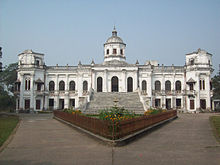|
Rangpur District
Rangpur District (Bengali: রংপুর জেলা) is a district in Northern Bangladesh. It is a part of the Rangpur Division.[4] GeographyUnder the Rangpur Division (one of eight divisions) composed of eight districts of northern Bangladesh, the District of Rangpur is bordered on the north by Nilphamari District, on the south by Gaibandha District, on the east by Kurigram, and on the west by Dinajpur district. Rangpur town is the divisional headquarter. The soil composition is mainly alluvial soil (80%) of the Teesta River basin, and the remaining is barind soil. The temperature ranges from 32–11 °C (90–52 °F), and the annual rainfall averages 2,931 mm (9.616 ft).[5] TravelThe main transportation methods here are by air, rail, or road. To travel by air, people have to first travel to Dhaka Domestic Airport and then fly to Saidpur Airport (DAC-SPD route). Seven flights travel this route daily. The US-Bangla Airlines, Novoair, and the Biman offer the flights. The distance by airways from Dhaka to Saidpur is 254.28 km (158 mi). By rail, the district is accessible from Kamalapur Railway Station which runs a daily-except-Sunday train "Rangpur Express" to Rangpur Railway Station. The total journey by rail is of 453 km (281 mi). By road, travelers have to travel 307 km (191 mi) using the Savar-Kaliakair route or 327 km (203 mi) using the Tongi-Mawna route, Shamu. HistoryRangpur was conquered by the army of Raja Man Singh, a commander of the Mughal emperor, and Akbar, in 1575, but it was only until 1686 that it was fully integrated into the Mughal Empire. Place names such as Mughalbasa ('Mughal locality') and Mughalhat ('Mughal market') bear testimony to the Mughal association and past of Rangpur and its hinterland. Later on, Rangpur passed under the control of "Sarker" of Ghoraghat. During the period of the East India Company, the Fakir-Sannyasi rebellion took place.[6] The Greater Rangpur district was divided in five districts in 1984. The population of the district is 2.9 million according to the 2011 census. There has been a 1.2% annual population growth between 2001 and 2011. The population density of the area is 1,200/km2 . Demographics
According to the 2022 Census of Bangladesh, Rangpur District had 834,307 households and a population of 3,169,614, of whom, 32.55% of the inhabitants lived in urban areas. 17.54% of the population was under 10 years of age. The population density was 1,320 people per km2. The literacy rate (age 7 and over) was 70.73%, compared to the national average of 74.80%, and the sex ratio was 98.04 females per 1000 males.[2]
Muslims make up 90.64% of the population, while Hindus are 8.96% of the population. The majority of Hindus are Rajbanshis. Other minorities are mainly Christians who are found among ethnic minorities. The ethnic population was 15,947 (0.50%), of which 8,580 were Oraon and 4,687 Santal.[2] Administrative sub-divisions The district has 1 city corporation and 3 municipalities, namely, Rangpur city corporation, Badarganj, Haragach and Peerganj, and eight Upazilas, namely: Rangpur town, covering an area of around 43 square kilometers, lies on the bank of the Ghaghat river and was turned into a municipality back in 1869. Rangpur City Corporation, which was founded in 1979, has a population of 294,000. The city has an area of 50.7 km2 (19.6 sq mi).[9] Education
Other prominent educational institutions include Rangpur Government College, Begum Rokeya College, and Govt. Commercial Institute. Besides there is one polytechnic institute, one vocational institute, around 282 high schools, 722 government primary schools, 38 junior high schools, 193 NGO (Non-Government Organization) operated schools and almost 370 Madrasahs in Rangpur. Rangpur Model College is now an honors college. Places of interest Just south of the city of Rangpur lies the Tajhat Zamindar's palace. After the end of the British Raj, the building was abandoned and decayed rapidly, although it was used for a few years as a courthouse during the 1980s. In the year 2004, it was largely restored and turned into a museum with ancient inscriptions, art, and coins from the area on display. RDRS (Rangpur and Dinajpur Rural Service) Bangladesh,[12] an NGO in northwest Bangladesh, has a large office and guesthouse/convention center in the town of Rangpur. A museum and women's training center was established in Pairabondh, the birthplace of Begum Rokeya. It is half an hour's drive away from Rangpur city.  There is an ancient auditorium named 'Town Hall' at the center of the city, where different cultural programs are held. In the great Rangpur region, no economic development took place until the 90's, mainly because of the yearly flooding the region used to see before the making of "Teesta Barrage." "Bhinno Jogot" is a theme park and a picnic spot which is situated 15 kilometers from Rangpur Town. Jadu Nibash in Radhaballav was the house of former senior minister of Bangladesh, Mashiur Rahman Jadu Mia (1924–1979). MediaBangladesh Betar Rangpur (BBR) has a broadcasting station in Rangpur. Bangladesh Television (BTV) has a satellite station in Rangpur. The Rangpur Press Club is situated in Rangpur. Rangpur has almost 19 cinema halls. There are several locally published newspapers in the district. Development organisationsRDRS Bangladesh – previously Rangpur-Dinajpur Rural Service – has its main operational headquarters in Rangpur town at the RDRS Complex.[12] Notable people
Members of tenth Jatiyo SangsadThe members of the national parliament are:[13]
Notes
References
External linksWikimedia Commons has media related to Rangpur District.
|
||||||||||||||||||||||||||||||||||||||||||||||||||||||||||||||||||||||||||||||||||||||||||||||||||||||||||||||||||||||||||||||||||||||||||||||||||||||||||||||||||||||||||







